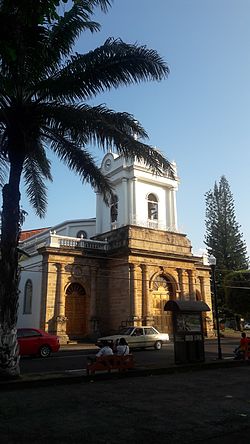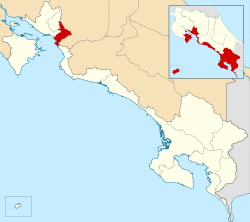Esparza Canton
| Esparza | |
|---|---|
| Cantón | |

Historic Catholic Church, Esparza
|
|
 Location of Esparza Canton in Puntarenas Province |
|
| Country | Costa Rica |
| Province | Puntarenas |
| Area | |
| • Total | 216.80 km2 (83.71 sq mi) |
| Population (June 2013) | |
| • Total | 34,291 |
| • Density | 160/km2 (410/sq mi) |
Esparza is the second canton in the province of Puntarenas in Costa Rica. The canton covers an area of 216.80 km², and has a population of 34,291. Its capital city is also called Esparza.
The major portion of the canton lies along the coast of the Gulf of Nicoya between the mouths of Río Barranca and the Río Jesús María. An extension of the canton reaches northward from Esparza into the Cordillera de Tilarán.
The canton of Esparza is subdivided into 6 distritos (districts).
Esparza was first mentioned as a canton in a decree dated December 7, 1848.
The territory of the canton of Esparza was first inhabited by the Chorotega and Huetar cultures. The first belonged to the province of Orotina (one of five Chorotega provinces), ruled by King Gurutiña. The Huetar belonged to the western Huetar kingdom, dominated at the time of the Spanish conquest by King Garabito, or Coyoche, one of the key leaders of the Costa Rican indigenous resistance.
In 1522, Don Gil González Dávila was the first Spanish visitor to the region, journeying from Burica to the indigenous village of Avancari (now Abangaritos , in the canton of Puntarenas).
In 1561, Don Juan de Cavallón y Arboleda, was commissioned by the Royal Audiencia of Guatemala to conquer the province of Nuevo Cartago and Costa Rica. He founded the town of Los Reyes, with the port of Landecho in Tivives Cove, within the Canton of Esparza.
In 1574, Alonso Anguciana de Gamboa, acting governor, relocated citizens of the town of Aranjuez to found the first seat of the city of Espíritu Santo (5km from the current site of Esparza), in the valley then known as Coyoche, between the Barranca and Jesus Maria rivers, near the present village of Artieda.
There the citizens constructed a small chapel, and shortly afterwards the convent of San Lorenzo, whose first priest was Fray Diego de Guillon. In 1576 the chapel was established within a parish, dedicated to Our Lady of Candelaria. The parish is now suffragan to the diocese of Puntarenas, in the ecclesiastical province of Costa Rica. In 1577 (a year later), the governor of the province, Diego de Artieda y Chirino, established the port of Caldera, replacing Landecho.
Artieda changed the name of the town, adding "Esparza" to the name of the "Ciudad del Espíritu Santo". He did this in memory of his hometown, the village of Esparza, located in the valley of Salazar, in Navarra, Spain, 80 km from the capital of the province, Pamplona. Between 1622 and 1629 the second and final seat of the Ciudad del Espíritu Santo de Esparza was established about five kilometers northwest of its original location. In 1685 the city was sacked by pirates. The following year (1686), pirates burned most of the town, except the church and convent of San Lorenzo. The people were forced to flee inland, taking refuge in Las Cañas and Bagaces.
...
Wikipedia
